List vs Set:深入剖析Java两大集合的核心区别与实战应用
本文旨在深度解析Java集合框架中最为核心的
List和Set接口。通过源码分析、性能对比、实战场景**,彻底搞懂它们的设计哲学和使用场景。本文配有清晰的对比表格、代码示例、UML图,无论是面试准备还是项目开发,都能提供有力支持!
📊 一、核心区别总览
| 特性维度 | List接口 | Set接口 |
|---|---|---|
| 元素唯一性 | ✅ 允许重复元素 | ❌ 不允许重复元素 |
| 顺序保证 | ✅ 严格的插入顺序 | ❌ 不保证顺序(部分实现有特殊顺序) |
| 索引支持 | ✅ 支持基于索引的访问 | ❌ 不支持索引访问 |
| 实现类示例 | ArrayList, LinkedList, Vector | HashSet, TreeSet, LinkedHashSet |
| 判重机制 | 依赖equals()方法 | 依赖hashCode()和equals()方法 |
| 性能特点 | 随机访问快,插入删除慢 | 查找速度快,自动去重 |
🔍 二、源码级深度解析
2.1 List接口的核心特性
List的继承体系:
public interface List<E> extends Collection<E> {// 核心方法:索引相关操作E get(int index);E set(int index, E element);void add(int index, E element);E remove(int index);int indexOf(Object o);
}
ArrayList的add方法源码分析:
// ArrayList.java
public boolean add(E e) {modCount++;add(e, elementData, size);return true;
}private void add(E e, Object[] elementData, int s) {if (s == elementData.length) // 容量检查elementData = grow(); // 动态扩容elementData[s] = e; // 直接放入数组size = s + 1;
}
LinkedList的节点结构:
// LinkedList的节点定义
private static class Node<E> {E item; // 存储的元素Node<E> next; // 指向下一个节点Node<E> prev; // 指向上一个节点Node(Node<E> prev, E element, Node<E> next) {this.item = element;this.next = next;this.prev = prev;}
}
2.2 Set接口的唯⼀性保证
HashSet的add方法源码:
// HashSet.java - 底层基于HashMap实现
public boolean add(E e) {return map.put(e, PRESENT) == null; // PRESENT是虚拟值
}// HashMap的putVal方法关键逻辑
final V putVal(int hash, K key, V value, boolean onlyIfAbsent) {// ... if (p.hash == hash &&((k = p.key) == key || (key != null && key.equals(k))))// 关键:先比较hash,再比较equalsreturn p; // 已存在,返回旧值// 不存在,插入新节点if (++size > threshold)resize(); // 扩容afterNodeInsertion(evict);return null; // 插入成功
}
TreeSet的红黑树实现:
// TreeSet使用TreeMap实现
public TreeSet() {this(new TreeMap<E,Object>()); // 基于红黑树
}// 元素必须实现Comparable接口,或提供Comparator
public boolean add(E e) {return m.put(e, PRESENT) == null;
}
⚡ 三、性能对比实测
3.1 不同操作的性能测试
public class ListVsSetPerformanceTest {private static final int SIZE = 100000;public static void main(String[] args) {// 测试数据准备List<Integer> arrayList = new ArrayList<>();List<Integer> linkedList = new LinkedList<>();Set<Integer> hashSet = new HashSet<>();Set<Integer> treeSet = new TreeSet<>();// 1. 添加性能测试long start = System.currentTimeMillis();for (int i = 0; i < SIZE; i++) {arrayList.add(i);}System.out.println("ArrayList添加耗时: " + (System.currentTimeMillis() - start) + "ms");start = System.currentTimeMillis();for (int i = 0; i < SIZE; i++) {hashSet.add(i); // HashSet的添加需要计算hash}System.out.println("HashSet添加耗时: " + (System.currentTimeMillis() - start) + "ms");// 2. 查找性能测试start = System.currentTimeMillis();arrayList.contains(50000); // O(n)遍历System.out.println("ArrayList查找耗时: " + (System.currentTimeMillis() - start) + "ms");start = System.currentTimeMillis();hashSet.contains(50000); // O(1)哈希查找System.out.println("HashSet查找耗时: " + (System.currentTimeMillis() - start) + "ms");// 3. 去重性能对比List<Integer> listWithDuplicates = Arrays.asList(1, 2, 2, 3, 3, 3, 4, 4, 4, 4);// 使用List去重(传统方式)List<Integer> distinctList = new ArrayList<>();for (Integer num : listWithDuplicates) {if (!distinctList.contains(num)) { // 每次都要遍历!distinctList.add(num);}}// 使用Set去重(一行代码)Set<Integer> distinctSet = new HashSet<>(listWithDuplicates);}
}
3.2 性能测试结果分析
| 操作类型 | ArrayList | LinkedList | HashSet | TreeSet |
|---|---|---|---|---|
| 添加元素 | O(1) 摊销 | O(1) | O(1) 摊销 | O(log n) |
| 随机访问 | O(1) | O(n) | 不支持 | 不支持 |
| 包含检查 | O(n) | O(n) | O(1) | O(log n) |
| 插入删除 | O(n) | O(1) | O(1) | O(log n) |
🎯 四、实战应用场景
4.1 List的典型使用场景
场景1:需要保持顺序的数据集合
// 电商订单列表 - 需要保持下单顺序
public class OrderService {private List<Order> orderList = new ArrayList<>();public void addOrder(Order order) {orderList.add(order); // 按照时间顺序存储}public Order getLatestOrder() {return orderList.get(orderList.size() - 1); // 获取最新订单}
}
场景2:需要索引操作的场景
// 分页查询实现
public class PaginationService {public <T> List<T> getPage(List<T> data, int page, int size) {int fromIndex = (page - 1) * size;int toIndex = Math.min(fromIndex + size, data.size());if (fromIndex >= data.size()) {return Collections.emptyList();}return data.subList(fromIndex, toIndex); // List特有的子列表操作}
}
4.2 Set的典型使用场景
场景1:快速去重
// 用户标签去重
public class TagService {public Set<String> processTags(List<String> inputTags) {return new HashSet<>(inputTags); // 自动去重!}// 统计独立访客public int countUniqueUsers(List<User> users) {Set<Long> userIds = users.stream().map(User::getId).collect(Collectors.toSet());return userIds.size(); // 自动去重后的数量就是独立用户数}
}
场景2:关系判断和集合运算
// 社交网络好友关系
public class SocialNetworkService {private Map<Long, Set<Long>> userFriends = new HashMap<>();// 判断是否为好友public boolean areFriends(long user1, long user2) {return userFriends.getOrDefault(user1, Collections.emptySet()).contains(user2);}// 获取共同好友public Set<Long> getMutualFriends(long user1, long user2) {Set<Long> friends1 = userFriends.getOrDefault(user1, Collections.emptySet());Set<Long> friends2 = userFriends.getOrDefault(user2, Collections.emptySet());Set<Long> mutualFriends = new HashSet<>(friends1);mutualFriends.retainAll(friends2); // 集合交集运算return mutualFriends;}
}
🔄 五、高级特性与注意事项
5.1 线程安全问题
// 不安全的做法
List<String> unsafeList = new ArrayList<>();// 安全的做法
List<String> safeList = Collections.synchronizedList(new ArrayList<>());
// 或者使用CopyOnWriteArrayList
List<String> concurrentList = new CopyOnWriteArrayList<>();// Set的线程安全版本
Set<String> safeSet = Collections.synchronizedSet(new HashSet<>());
Set<String> concurrentSet = new ConcurrentHashMap.newKeySet();
5.2 equals和hashCode的重写要求
// 自定义对象在Set中使用的正确姿势
public class User {private Long id;private String name;private String email;// 必须重写equals和hashCode@Overridepublic boolean equals(Object o) {if (this == o) return true;if (o == null || getClass() != o.getClass()) return false;User user = (User) o;return Objects.equals(id, user.id) && Objects.equals(email, user.email);}@Overridepublic int hashCode() {return Objects.hash(id, email); // 使用业务唯一标识字段}
}// 测试
Set<User> userSet = new HashSet<>();
User user1 = new User(1L, "Alice", "alice@example.com");
User user2 = new User(1L, "Alice", "alice@example.com");userSet.add(user1);
userSet.add(user2); // 不会重复添加,因为equals和hashCode相同System.out.println(userSet.size()); // 输出:1
💡 六、面试常见问题
Q1: ArrayList和LinkedList如何选择?
A: 根据操作类型选择:
- 查询多、增删少 → 选择
ArrayList(随机访问O(1)) - 增删多、查询少 → 选择
LinkedList(插入删除O(1)) - 需要线程安全 → 考虑
CopyOnWriteArrayList
Q2: HashSet如何保证元素唯一性?
A: 通过两个步骤:
-
首先比较对象的
hashCode()值 -
如果hashCode相同,再比较
equals()方法 -
两者都相同则认为重复,不插入
Q3: TreeSet的排序规则?
A: 两种方式:
- 自然排序:元素实现
Comparable接口 - 定制排序:创建TreeSet时传入
Comparator
📚 七、总结与最佳实践
选择决策流程图:

核心记忆要点:
- List:有序可重复,支持索引
- Set:唯一不重复,快速查找
- ArrayList:数组实现,查询快
- HashSet:哈希实现,去重快
- 根据业务需求选择最合适的实现
🎯 下期预告
《Map深度解析:HashMap、TreeMap、ConcurrentHashMap全对比》
- HashMap的扩容机制与线程安全问题
- TreeMap的红黑树实现原理
- ConcurrentHashMap的并发优化策略
📌 版权声明:本文为CSDN博主原创,转载请注明出处。欢迎点赞、收藏、关注!
💬 互动话题:你在项目中遇到过哪些因为错误选择集合类型导致的性能问题?欢迎在评论区分享你的经验!
